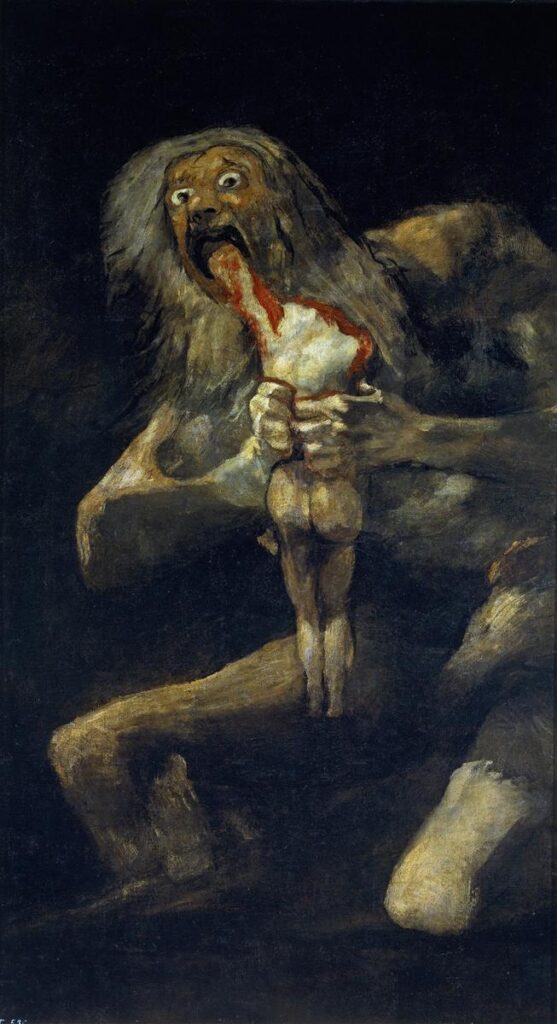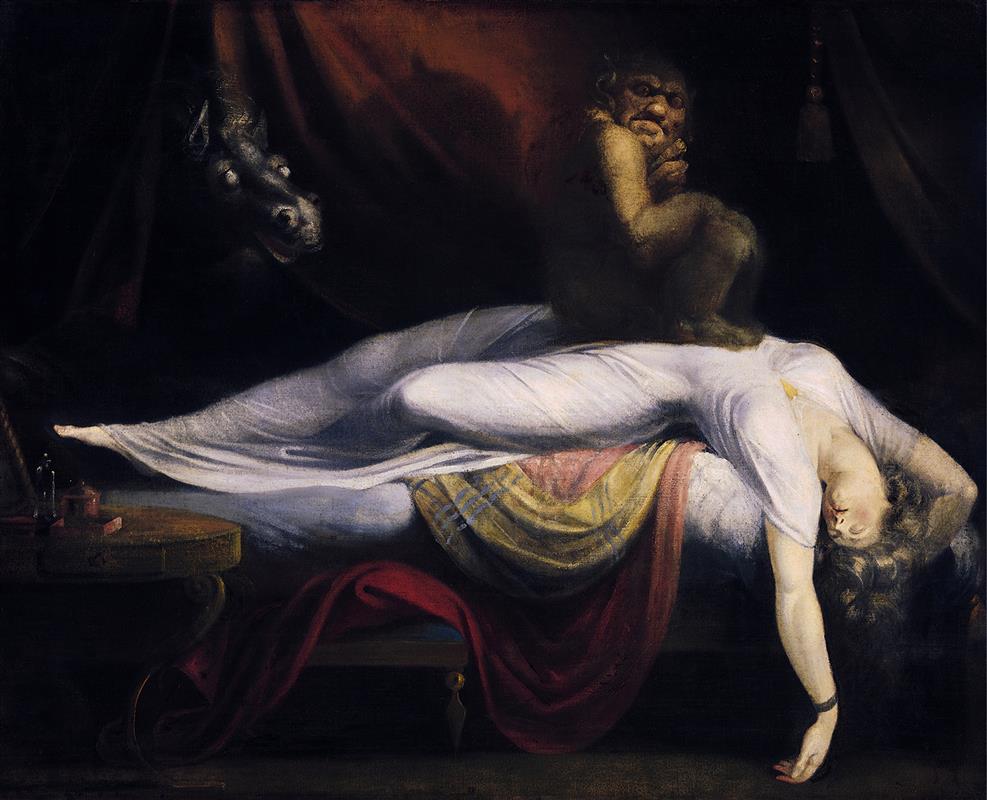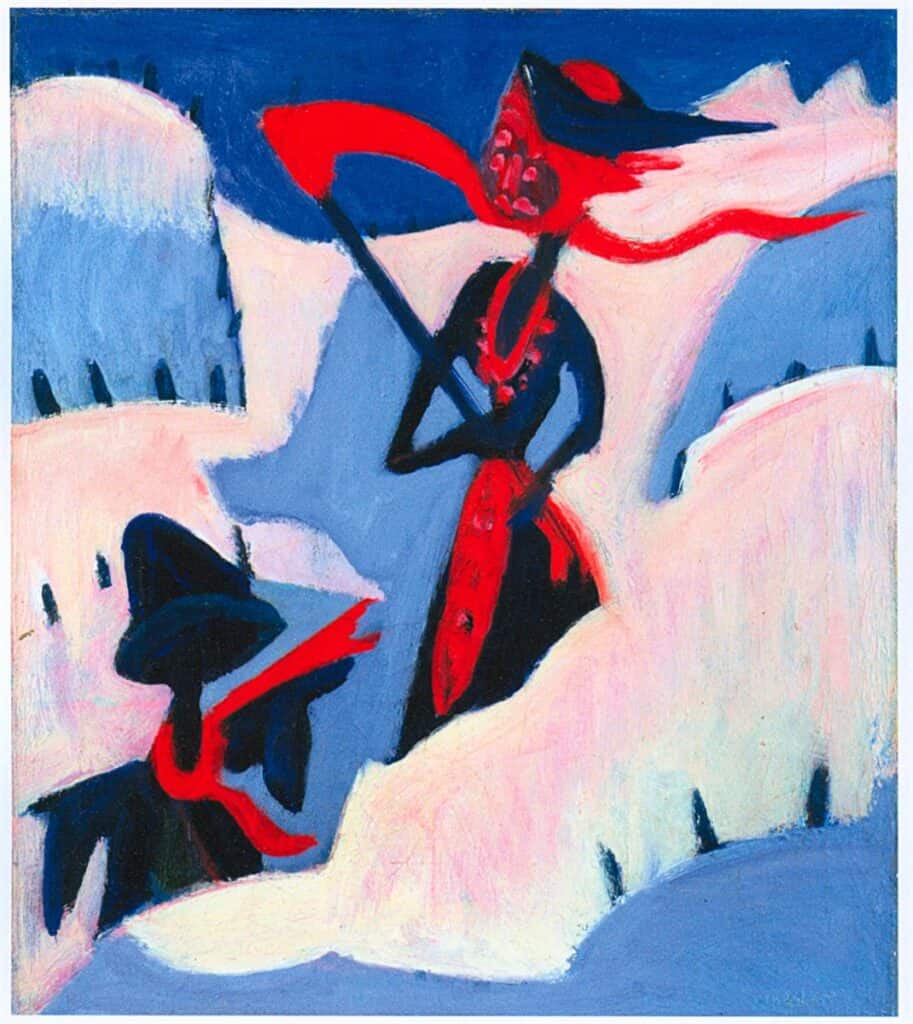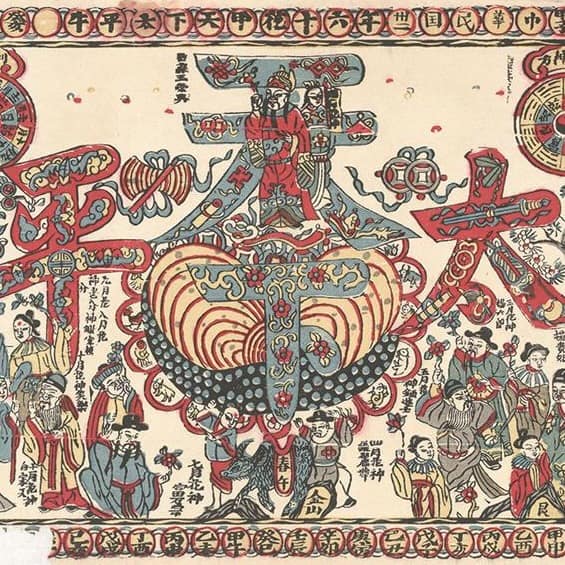8 of the Best Spooky Artworks in Art History
Why should art always dance in the sunlight, wrapped in vivid hues and playful strokes? As autumn’s chill creeps in and shadows lengthen, a world of art is waiting in the twilight. It’s spooky season, after all!
So, let’s captivate the young, curious minds with some of the eeriest, most mysterious, and haunting artworks in art history.
From Fuseli’s gothic dreams to Japanese folklore, are you ready to uncover the chilling beauty of these masterpieces?
Looking for more spooky content? Check out our favourite Halloween books for kids!
From Fuseli to Kuniyoshi: Spooky Artworks to Explore This Halloween
Francisco Goya, “Saturn Devouring His Son”

One of Francisco Goya’s most harrowing and memorable paintings, “Saturn Devouring His Son,” belongs to a dark and unsettling series known as the “Black Paintings.” Painted between 1819 and 1823, this collection was created during a tumultuous period in both Spain’s history and Goya’s personal life.
In “Saturn Devouring His Son,” the scene is dominated by the gruesome image of the Titan god, Saturn (known as Cronus in Greek mythology), consuming one of his children. According to myth, Saturn had devoured each of his children upon their birth, fearing a prophecy that one would overthrow him. Goya’s interpretation is particularly brutal, depicting Saturn in a wild frenzy, eyes wide with madness, as he grips and consumes his offspring.
Read also: 10 Powerful Examples of Art That Sparked Social Change
Several elements heighten the painting’s disturbing aura. The stark, dimly lit background focuses on the central horror, while the contrasting textures of Saturn’s matted hair and raw, bloody flesh underscore the savagery of the act. There’s an immediacy and rawness to the painting, making the viewer feel as though they’ve stumbled upon a moment of unspeakable horror.
The “Black Paintings,” including this one, were not commissioned works. Instead, Goya painted them directly onto the walls of his home, the Quinta del Sordo (House of the Deaf Man). They were transferred to canvas after his death. Given the dark themes and personal nature of these paintings, they’re often viewed as a reflection of Goya’s disillusionment and despair during his later years.
Historically, Goya lived through significant political upheavals in Spain, including the Peninsular War and the Inquisition’s return. The profound impact of these events on the artist is evident in the evolution of his work, moving from the light-hearted tapestry designs and royal portraits of his early career to the darker, more introspective works of his later years.
Pieter Bruegel the Elder, Mad Meg

Painted in 1562, this artwork stands out as one of Bruegel’s most enigmatic and discussed creations.
At the painting’s center is the titular character, Dulle Griet, a fearsome woman wearing a soldier’s helmet, brandishing a sword, and leading a band of women into a hellish landscape. The world around her is one of chaos and disorder, populated by bizarre creatures and scenes of devastation. Buildings are ablaze, strange demonic entities roam freely, and the whole landscape seems to be a blend of the real and the fantastical.
The character of Dulle Griet is a complex one. In Flemish folklore, she represents a shrewish woman, and her name is often invoked in old tales and proverbs. By placing this folkloric character against a backdrop reminiscent of Hieronymus Bosch’s hellscapes, Bruegel might be making a commentary on human folly, societal norms, or the chaos of war.
Various interpretations of the painting exist. Some suggest that it’s a critique of violent feminine power, while others see it as a broader comment on the destructive nature of humanity. The scene where Meg is raiding Hell to retrieve household items could be seen as a commentary on material greed or the absurdity of human desires.
“Dulle Griet” is, in many ways, a product of its time. The 16th century in Europe was marked by religious upheavals, societal changes, and conflicts; through his detailed and allegorical style, Bruegel provided a window into the tensions and uncertainties of the period.
Louise Bourgeois, Maman

At over 30 feet tall, Louise Bourgeois’s “Maman” is a commanding presence. Crafted in bronze, stainless steel, and marble, this monumental spider sculpture stands tall on slender legs, casting a wide net of shadows beneath. Its body arches overhead, carrying a sac filled with marble eggs beneath its abdomen. With meticulous detailing from its spindly legs to the textured surface of its body, “Maman” combines the eerie and the awe-inspiring.
The title “Maman,” French for “Mother,” gives a clue to the profoundly personal symbolism of the artwork. For Bourgeois, the spider symbolizes her own mother, with its protective and nurturing nature. Her mother, a tapestry restorer, was likened to a spider, a tireless weaver and mender.
The intricacy of the web, much like the detailed fabric her mother would have worked with, mirrors the complexities of relationships, especially the bond between a mother and her child. The marble eggs under the spider’s body represent fertility, protection, and perhaps the fragility of life.
Henry Fuseli, The Nightmare

Henry Fuseli’s iconic painting “The Nightmare” was created in 1781 and quickly became one of his most recognized works. The Swiss-born artist, who later adopted England as his home, played a pivotal role in the Romantic art movement, known for its emphasis on emotion and individualism.
“The Nightmare” is a striking representation of these Romantic ideals. The painting portrays a woman in a deep sleep, sprawled across a bed. Above her rests an eerie, goblin-like creature known as an incubus, staring out directly at the viewer. To the side, a ghostly horse with wide, glaring eyes emerges from the shadows, adding to the scene’s unsettling atmosphere.
Several elements in the artwork challenge the norms of 18th-century painting. Instead of traditional, idyllic representations, Fuseli delves into the world of dreams and the subconscious, capturing the terror and unpredictability of nightmares.
Henry Fuseli’s interest in literature, especially the works of Shakespeare and Milton, often influenced his paintings. The themes of terror, the supernatural, and the macabre, which were popular in Gothic literature of the time, are evident in “The Nightmare.”
In an art world dominated by the refined aesthetics of Neoclassicism, Fuseli’s decision to depict the darker aspects of the human psyche was groundbreaking. “The Nightmare” not only embodies the spirit of Romanticism but also foreshadows the Symbolist movement of the late 19th century, which would further explore themes of dreams and the subconscious.
Kunisada, Ghost of the Wet Nurse Iohata

Kunisada’s “Ghost of the Wet-Nurse Iohata” captures the ethereal realm of yūrei, or Japanese ghosts, with exquisite poignancy. In this ukiyo-e woodblock print, Kunisada masterfully presents the spirit of Iohata, a wet nurse floating above a tempestuous river surrounded by swirling mists and will-o’-the-wisps. Her flowing white garments, disheveled hair, and the pale countenance immediately identify her as a spectral entity, a common representation of yūrei in traditional Japanese art.
The choice of a wet nurse as the central figure is significant. Wet nurses often played crucial roles in Japanese households, caring for and nourishing the young. Yet, their outsider status in the families they served could sometimes lead to tragic tales of love, sacrifice, and sorrow. In this portrayal, Iohata’s ghost carries with it an air of melancholy and longing, possibly pointing towards an unresolved narrative from her earthly existence.
Kunisada’s artwork resonates with deep cultural undertones. Yūrei, like Iohata, are believed to be spirits bound to the earthly realm due to some strong emotion, unfulfilled duty, or sudden death. Their hauntingly beautiful appearance in artworks often signifies unresolved matters and the impermanence of life.
Hieronymus Bosch, The Temptation of St. Anthony

“The Temptation of St. Anthony” is a standout painting by the Dutch artist Hieronymus Bosch. Born around 1450 in ‘s-Hertogenbosch, Netherlands, Bosch became known for his detailed and often eerie paintings that mix religious themes with strange, imaginative creatures. In a time when most art was about religion or portraits, Bosch’s unique and sometimes dark style set him apart.
The painting shows St. Anthony, a monk, surrounded by all kinds of weird creatures, representing the temptations and challenges he faced in the desert. While the central part is full of chaos, the two smaller scenes on the sides give a fuller story. One shows St. Anthony being troubled by some of these creatures, while the other gives a more peaceful image, perhaps after he’s managed to overcome his challenges.
Ernst Ludwig Kirchner, Witch and Scarecrow in the Snow

Ernst Ludwig Kirchner, a central figure in the German Expressionist movement known as Die Brücke (“The Bridge”), is renowned for his vibrantly colored, distorted depictions of urban life, landscapes, and figures. His works often carry an intensity reflective of the psychological and societal tensions of the early 20th century.
“Witch and Scarecrow in the Snow” is a lesser-known work of Kirchner’s, but it encapsulates the artist’s signature style and thematic inclinations. Painted in 1932, the piece presents a stark winter landscape punctuated by the haunting presence of a witch-like figure and a scarecrow. The scene is rendered in bold, contrasting colors, with the snow serving as a blank canvas against which the figures are dramatically set.
The witch in Kirchner’s painting doesn’t resemble the traditional hag-like depiction commonly seen in folklore. Instead, she is portrayed in a manner reminiscent of Kirchner’s urban street scenes, with a sense of modernity and rawness. The scarecrow, though an inanimate object, is given an almost lifelike quality, adding an eerie dynamic between it and the witch.
The symbolism of the witch and the scarecrow can be seen in various ways. Witches, historically, have represented the “other” or the outcast, and their presence in art often signifies societal anxieties or fears. The scarecrow, traditionally a guardian of crops, might symbolize protection or a sentinel against threats. Together, they create a scene of isolation in the desolate snowy landscape, perhaps suggesting themes of alienation, otherness, or the juxtaposition of the animate and inanimate.
Kirchner’s use of bold colors, sharp lines, and distorted forms in this piece is emblematic of the Expressionist movement’s desire to convey emotional experience over realistic representation. The movement, born out of a period of rapid urbanization and societal change in Germany, sought to capture the psychological responses to these shifts.
Kiki Smith, Spider

Much like Louise Bourgeois, Kiki Smith engages with the spider as a motif of feminine power and creativity. The spider, as a creature, weaves intricate webs, akin to the crafting of stories, life paths, or even the very fabric of existence. This act of weaving resonates with themes of creation, both in the sense of artistic creation and the broader, almost mythological sense of world-building.
For Smith, the spider also connects to ideas of regeneration and cyclical patterns of life. Spiders, in their daily routines, create, destroy, and recreate their webs. This resonates with human experiences of growth, decay, and rebirth, themes Smith frequently touches upon in her broader oeuvre.
Furthermore, the spider has been historically linked with feminine archetypes. In many cultures, spiders are seen as guardians of ancient knowledge, weavers of fate, and embodiments of patience and strategy. Smith’s “Spider” can be seen as a homage to this lineage of female strength, wisdom, and resilience.
What do you think? Are there any particular artworks that give you the chills? Let me know in the comments below!
Save for Later:












